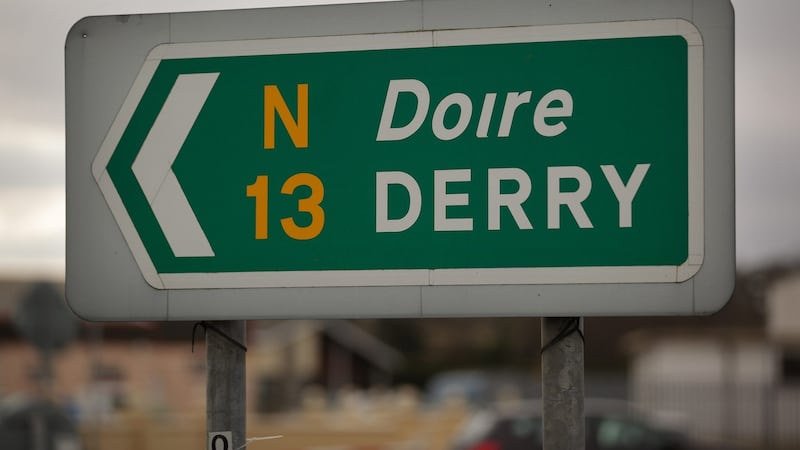Belfast’s new Glider high-quality bus system serves unionist east Belfast and nationalist west Belfast with a single through route. There had previously been no way to make this journey uninterrupted.
Heartening scenes were witnessed when the service began two weeks ago, as people spontaneously set out to see the other half of their city, in some cases for the first time. It briefly became a fad and welcomes were received all round.
Then came the inevitable let-down. In 2011, following local consultation, Northern Ireland's public transport operator, Translink, introduced English/Irish bilingual destination signs on buses serving west Belfast, along with timetables and other information. To preserve this on the cross-city Glider route, it has been announced that the signs will switch from English-only to Irish/English in west Belfast, then switch back on entering the city centre.
This has provoked a great deal of hand-wringing from people who have apparently never encountered a bog-standard European language dispute.
Glider buses are made in Belgium, where an even stricter policy applies across the entire country – only the official language of each region is used on public transport, with languages switched mid-journey on through services. But bilingualism is allowed in the shared capital of Brussels, so this parallel does not cover the exclusion of Irish from central Belfast. Even to those not contriving their indignation, the Glider story is petty, embarrassing and inadequately resolved.
Yet there is still something of the future about it – a hint of where technology could be taking us all.
Electronic insults
Ten years ago, Sinn Féin called on supporters to campaign against electronic insults to nationalism: sat navs that direct you to "Londonderry"; phones that welcome you "to Ireland" when crossing the Border; RTÉ websites that declare you outside Ireland when north of the Border.
Would Sinn Féin consider the Glider signs, about which it has been strangely quiet, an instance of this problem or a solution to it?
If the aim is providing the correct language and terminology for a particular audience, Glider buses use satellite tracking and electronic displays to deliver this on a geographic basis, which will never suit everybody.
So the next step is delivering it on an individual basis.
Quebec announced it will replace its French-only road signs with pictograms, rather than lift a legal ban on English to make signs bilingual
Translink offers mobile phone apps that allow customers to buy and display tickets, view timetables and track services in real time.
Would Irish-language versions of these apps meet the needs of Irish speakers anywhere on the transport network?
The current answer would be no: Irish speakers want their language to have equality and visibility, meaning bilingual signs in shared areas, and ideally everywhere. Even for nationalist non-speakers this is an important cultural signifier.
Alternative approaches
But logic no longer points inexorably to this outcome. Alternative approaches are becoming possible, or at least imaginable.
One tendency in language disputes is to simplify, not multiply. Last week, Quebec announced it will replace its French-only road signs with pictograms, rather than lift a legal ban on English to make signs bilingual.

Road signs themselves are on the way out. In March, Britain’s department for transport issued new guidelines after a report it commissioned found most signs are “entirely superfluous” and 90 per cent should be removed.
Tailored information
This new fashion for decluttering roads and streets coincides with the development of heads-up displays by car manufacturers, which will project signage inside windscreens.
Add in all the other tailored information on the phone in your pocket, and the promise (or threat) of targeted advertising in public places, via the phone’s knowledge of your whereabouts, and a science fiction scenario appears on the near horizon, with the physical environment denuded of divisiveness and everyone wandering around in their own little virtual bubble.
This would go beyond selecting a preferred language. People could tap a flag icon on their phone and never be troubled again by the wrong word for Derry or a welcome to their own country.
The ability of immigrant communities to live self-contained lives via modern technology, and hence never integrate, has been noted with concern by governments and academics for more than a decade. But is it a concern if a fundamentally divided society, such as Northern Ireland, uses technology to manage its divisions?
Real-time translation
All this is without considering the prospect of real-time translation. Google unveiled wireless ear buds last year claiming 98 per cent accuracy in certain language combinations. Perfecting this technology would be one of the most profound breakthroughs in history, making it laughable to consider its impact on Northern Ireland's quarrel. Nevertheless, the impact is coming – current models of an Irish language Act are premised on jobs and services translating government bumpf, which can be managed passably today at the touch of a button.
If you could converse with a bus driver in Irish, yet he or she never had to learn a word of it, would that be success or failure? And would both of you still be sharing enough reality to care?









